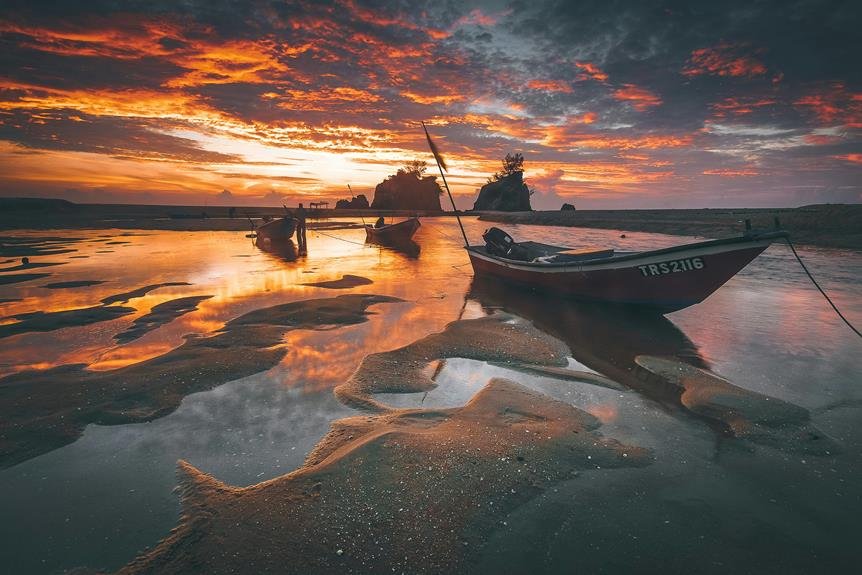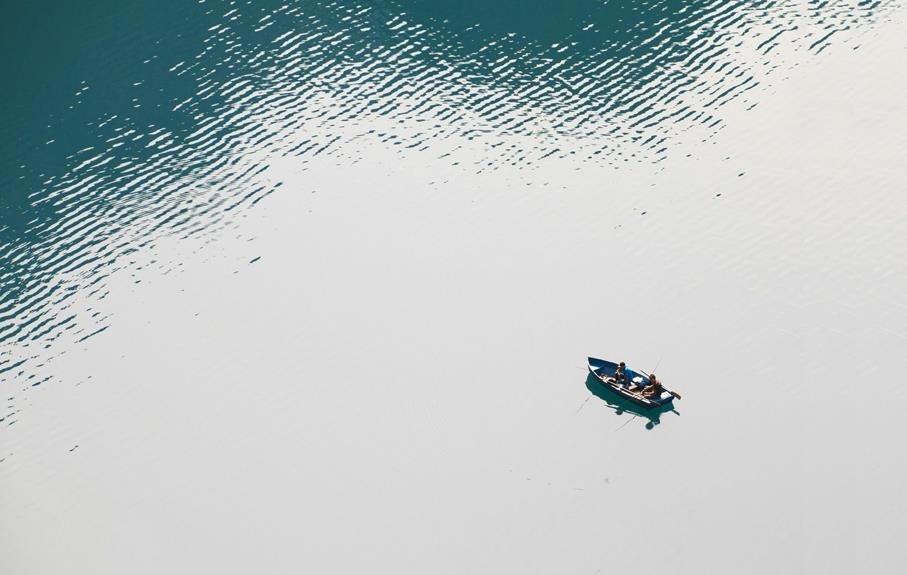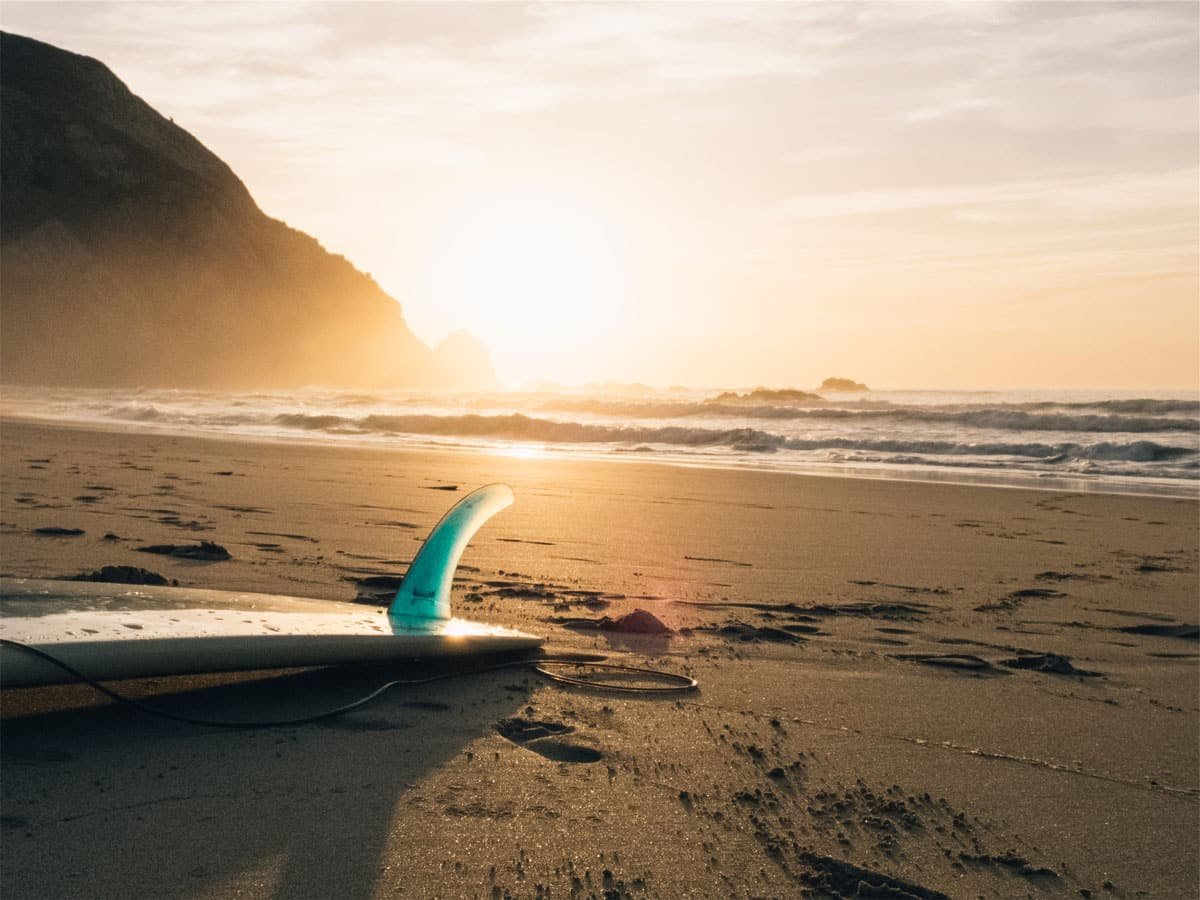Flats and backwater fishing present a unique set of challenges and opportunities for anglers, requiring a distinct set of skills and strategies tailored to these specialized environments. To succeed, you must equip yourself with medium-action rods, suitable tackle, and a sturdy boat capable of traversing shallow waters. Understanding tidal patterns, identifying productive inlets, and adapting to changing water conditions are vital. By mastering these nuances, you'll increase your chances of landing a catch. As you wade into the world of flats and backwater fishing, there's much more to explore, and the right approaches will reveal themselves with patience and persistence.
Key Takeaways
- A medium-action fishing rod with a spinning or baitcaster reel is a good starting point for backwater fishing.
- Choose a boat that can traverse shallow waters and handle the type of fishing being done, and ensure necessary licenses and permits.
- Identify productive inlets by understanding tidal patterns, water quality, and structure, and fish the edges where the tide is pushing baitfish.
- Fish the edges of marshes and mangroves where dense vegetation and shallow waters provide an ideal environment for fish to thrive.
- Analyze tidal patterns, identify structural elements, and vary presentation styles to entice fish in the edges of backwaters and flats.
Essential Fishing Tackle
When it comes to backwater fishing, a well-stocked tackle box and a versatile rod-and-reel combo are essential for success, as they enable anglers to adapt to changing conditions and target a variety of species. A medium-action fishing rod with a spinning or baitcaster reel is a good starting point. A 15-pound test braided line with a 20-30-pound fluorocarbon leader line provides a solid foundation. Hook sizes ranging from 1/0 to 3/0 will cover most bait sizes. A selection of lures, including gold metal spoons and soft plastic jigs, will help you adapt to changing conditions. Regular tackle maintenance is vital, so make sure to regularly inspect and clean your gear to verify it's in top condition. By prioritizing quality fishing gear and maintaining it properly, you'll be better equipped to handle the challenges of backwater fishing.
Reaching Fishing Spots
Reaching your backwater fishing spot often requires a boat, whether it's a small flats boat or a kayak, as these areas are typically inaccessible by foot. When selecting a watercraft, consider the type of fishing you'll be doing and the waters you'll be traversing. For example, a kayak is ideal for shallow, narrow waters, while a flats boat is better suited for open flats.
Watercraft Selection: Choose a boat that can traverse shallow waters and handle the type of fishing you'll be doing.
Fishing Licenses: Make sure you have the necessary licenses and permits to fish in your desired location.
Launch Points: Identify safe and accessible launch points for your watercraft.
Navigation: Familiarize yourself with the waters and pilot carefully to avoid damaging your boat or disturbing the environment.
Identifying Saltwater Inlets
Saltwater inlets, characterized by shallow sand bars or rocks that line deeper channels or sloughs, are prime fishing spots where predators and prey converge. These inlets are influenced by tidal cycles, which affect the movement and behavior of fish. Understanding the tidal patterns can help you locate areas where fish are more likely to congregate. Additionally, water quality plays a vital role in identifying productive inlets. Look for areas with good water clarity, as fish tend to avoid murky or polluted waters. Observe the inlet's structure, taking note of the depth and shape of the channels, as well as the presence of structure such as rocks, weed beds, or oyster bars. By paying attention to these factors, you can increase your chances of finding fish-rich inlets.
Fishing Inlet Strategies
How do you maximize your catch in a saltwater inlet, where the confluence of tidal currents and structural features creates a complex and dynamic environment? Understanding the intricacies of tide patterns and water clarity is vital. Here are some strategies to increase your catch:
- Read the water: Look for areas with a mix of sand, rocks, and weed beds, as these attract a variety of species.
- Fish the edges: Target areas where the tide is pushing baitfish into the inlet, creating ambush points for predators.
- Work with the current: Use the tide to your advantage by drifting or casting into the current to reach fish hiding behind structure.
- Adjust to changing conditions: Be prepared to adapt your tactics as water clarity and tide patterns change throughout the day.
Marsh and Mangrove Fishing
Frequently, anglers overlook the productive fishing grounds of marsh and mangrove areas, where a subtle understanding of the ecosystem can yield impressive catches. Marsh habitats, characterized by dense vegetation and shallow waters, provide an ideal environment for fish to thrive. Mangrove species, with their complex root systems, create a labyrinth of hiding spots for predators and prey alike. To capitalize on these areas, focus on the edges where the marsh grass or mangrove islands meet the water. Look for areas with moving water, such as creek mouths or estuaries, where fish are likely to congregate. By understanding the intricacies of these ecosystems, anglers can target species that call these areas home, increasing their chances of landing a prized catch.
Edge Fishing Techniques
When fishing the edges of marshes and mangroves, employ techniques that capitalize on the unique characteristics of these habitats, where structure and water movement dictate the behavior of the fish, as this is vital for success.
To effectively fish these edges, consider the following techniques:
- Analyze tidal patterns: Understand how the tides affect the movement of fish and structure in the marshes and mangroves.
- Identify structural elements: Look for areas with unique structural features, such as points, bends, or holes, where fish are more likely to congregate.
- Use the right tackle: Employ tackle that can withstand the strong currents and structure of the edges, such as heavy-test lines and sturdy hooks.
- Vary your presentation: Experiment with different lures, retrieval speeds, and presentation styles to entice fish in the edges.
Oyster Bar and Grass Bed Fishing
Oyster bars and grass beds, with their complex network of nooks and crannies, provide a unique challenge for anglers, requiring a thoughtful approach to tackle and presentation. These backwater reefs support the marine food chain, making them a hotspot for fish activity. When fishing oyster habitats, is crucial to suspend bait over the rough bottom using a popping cork, topwater lure, or a jig. Fish patrol the outside edges of the bars and grass beds, looking for prey that wanders too far away from the safety of the reef. A trolling motor or push pole can be an advantage when moving over structure to avoid spooking the fish. By understanding the intricacies of oyster habitats and reef systems, anglers can increase their chances of landing a catch in these challenging yet rewarding fishing spots.
Challenging Fishing Conditions
Challenging fishing conditions, such as strong currents, murky waters, and shifting weather patterns, can make backwater fishing a true test of skill and patience. Anglers must be prepared to adapt to these conditions to increase their chances of success.
Four key factors to bear in mind when facing challenging fishing conditions:
- Tidal surges: Strong tidal currents can make it difficult to present lures or bait effectively.
- Weather fronts: Sudden changes in weather can affect fish behavior and make them more or less active.
- Murky waters: Reduced visibility can make it harder to spot fish and present lures accurately.
- Shifting winds: Changing wind direction can affect the movement of fish and the presentation of lures.
Effective Fishing Techniques
By understanding how to adapt to challenging fishing conditions, anglers can focus on developing effective fishing techniques that increase their chances of success in the backwaters. A key aspect of this is adopting a flexible fishing mindset, willing to adjust tactics based on changing water conditions. Pay attention to the subtleties of the water, such as currents, tides, and water clarity, as these can greatly impact the behavior of your target species. By being attuned to these changes, you can refine your techniques to better suit the environment. For example, in murky waters, try using lures that create vibrations or noise to attract fish. In clear waters, opt for more subtle presentations. By staying adaptable and attentive to water conditions, you can develop a more effective fishing strategy.
Boating Strategies for Success
When cruising the backwaters, a well-planned boating strategy can make all the difference between a successful fishing trip and a frustrating one. A well-thought-out approach will help you conserve fuel, navigate safely, and increase your chances of catching fish. Here are some essential boating strategies for success:
- Tide Timing: Plan your trip according to the tides, as this will help you reach the best fishing spots at the right time.
- Fuel Efficiency: Optimize your fuel consumption by maintaining a moderate speed, avoiding unnecessary acceleration, and keeping your boat well-maintained.
- Route Planning: Chart your course in advance to minimize travel time and maximize fishing time.
- Safety First: Always prioritize safety, ensuring you have the necessary safety gear, communication devices, and a clear plan for emergency situations.
Mastering Backwater Fishing
As you refine your boating strategies and tackle selection, mastering backwater fishing requires a deep understanding of the unique characteristics of flats and backwater ecosystems. Timing is vital, as the tides profoundly impact fish behavior. During changing tides, fish tend to be more active, making them more susceptible to biting. Understanding these patterns allows you to position yourself in prime fishing spots. Pay attention to the water's clarity, temperature, and structure, as these factors influence fish behavior. By recognizing these nuances, you can adapt your techniques to increase your chances of landing a catch. By mastering these intricacies, you'll be well on your way to becoming a skilled backwater angler.
Frequently Asked Questions
What Clothing and Sun Protection Should I Wear While Backwater Fishing?
When spending hours on the water, prioritize comfort and protection with moisture-wicking shirts, polarized sunglasses, and a hat to shield your face and neck from the sun, ensuring a safe and enjoyable fishing experience.
How Do I Handle and Release Fish Without Causing Harm?
When handling fish for release, prioritize gentle grasping, avoiding gill plates and eyes, and minimize air exposure; for catch photography, cradle the fish horizontally, supporting its belly, and take quick, gentle photos to facilitate a safe, healthy release.
What Safety Precautions Should I Take When Navigating Shallow Waters?
When traversing shallow waters, prioritize safety by maintaining a slow pace, scanning for Shallow Hazards like sandbars and rocks, and being mindful of Propeller Damage to avoid costly repairs and environmental harm.
Can I Fish at Night in Backwater Areas, and if So, What Strategies Work Best?
At night, fish feed aggressively, making it an ideal time to catch species like snook and redfish. Use night vision to spot fish, and in clear water, employ techniques like live baiting or soft plastic lures to capitalize on nocturnal feeding frenzies.
What Are the Best Times of Day and Tidal Conditions for Backwater Fishing?
For ideal backwater fishing, target the changing tides during dawn and dusk when water clarity is best, as these periods often bring active feeding windows, and be prepared to adapt to shifting tide cycles and water conditions.
Conclusion
In the domain of flats and backwater fishing, mastery is a symphony of skill, knowledge, and tackle. By harmonizing these elements, anglers can orchestrate a triumphant catch. The rewards of this intricate dance between fish, environment, and angler are substantial, with the experience etched in memory like a work of art. As the sun sets on another day on the water, the flats and backwater yield their secrets to those who have mastered the art of reading the water, presenting the right lures, and adapting to the ever-changing environment.









